TL;DR
Set up your home office with ergonomic furniture, layered lighting, and clear zones to work smarter and feel inspired. To design a home office for productivity and creativity, start with a quiet location, arrange the desk to the side of a window, and add storage that keeps surfaces clear. Experts recommend a sit-stand routine, 300–500 lux task lighting, and a monitor set at eye level to reduce strain and increase focus.
Design a home office for productivity and creativity
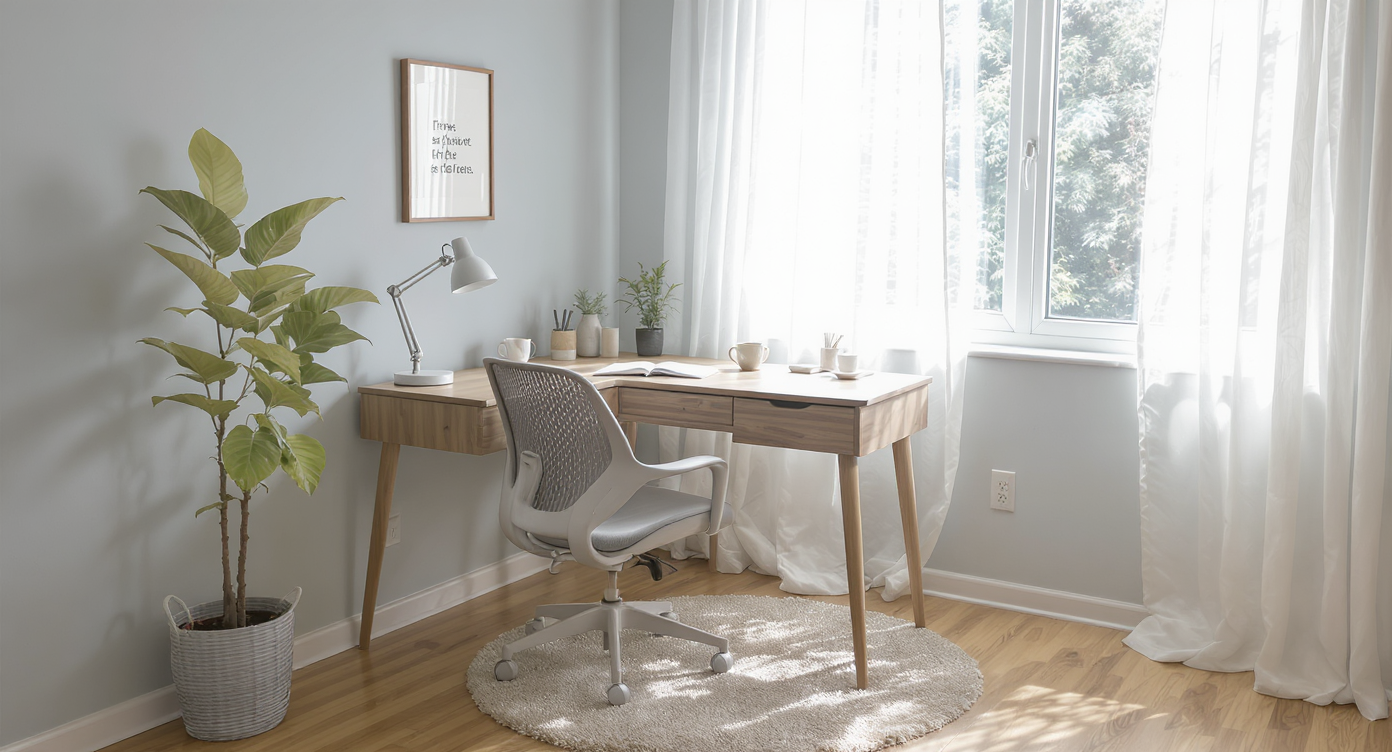
Placing your desk near a window enhances natural light and focus for a high-performing home office.
A high-performing home office starts with intent. The goal is simple: create a space where focus feels natural and creativity shows up on time. If you’ve wondered how to design a home office that boosts productivity and creativity, the essentials are location, layout, and light — then everything else builds from there.
Here’s the thing: remote work isn’t just a convenience anymore. A smart office design, with ergonomic seating, natural light, and clutter-free surfaces, anchors routines and reduces friction. Designers often advise placing the desk near a window for daylight, using an ergonomic chair, and zoning the room so it isn’t all work or all decor. Do that, and even a compact corner can work like a dedicated studio.
Core strategy: layout, ergonomics, light, and focus zones
Start with the room choice: a quiet area with a door, good natural light, and at least 36 inches of clearance behind the chair will instantly improve office design performance.
- Location and boundaries: Choose a space away from high-traffic zones. Visual boundaries matter; a rug or a low shelf can define the work zone in an open plan.
- Desk placement and view: Place the desk perpendicular to a window to capture natural light without glare on the screen. Keep the monitor top at or just below eye level and 20–28 inches from your eyes.
- Ergonomics that last: Aim for a 28–30 inch desk height, wrists straight, and feet flat with 90-degree angles at knees and hips. Experts recommend alternating sitting and standing; a 20-8-2 hour (sit-stand-move) pattern helps reduce fatigue.
- Layered lighting: Combine ambient (2700–3000K), task (300–500 lux at the desk, often 3500–4000K), and a soft backlight for video calls. Avoid a window directly behind you on camera to limit silhouette.
- Acoustics and comfort: Soften echo with a rug, curtains, and a bookcase. A door sweep and weatherstrip can trim distractions, while plants subtly improve perceived air quality.
- Storage and cable control: Keep daily tools within arm’s reach; archive the rest. Use a cable tray, velcro ties, and a surge-protected power strip mounted under the desk to keep floors clear.
- Color and materials: Blues and greens can support focus and creative thinking; warm neutrals calm the backdrop. One accent color (10–20 percent of the palette) adds energy without visual noise.
User insight: A client who worked at a dining table moved to a small east-facing alcove with a sit-stand desk and task lamp; her report time dropped by 30 minutes a day because setup and glare stopped getting in the way.
Anecdote
One client used a bold red wall that felt buzzy on video. We softened it to a muted green, added a linen shade, and his call feedback changed overnight: “calm, clear, confident.”
Common mistakes and misconceptions
These common pitfalls quietly drain focus and mood — and they’re easy to fix with a few home office ideas that prioritize function first.
- Dining-chair fatigue: Using a non-ergonomic chair causes neck and back strain. Choose an adjustable task chair with lumbar support and breathable fabric.
- Facing the window head-on: Direct sun equals screen glare. Shift the desk to the side of the window and add a sheer or solar shade.
- One harsh ceiling light: Sole overheads create shadows and eye strain. Add a desk lamp with a pivoting head and a warm ambient source.
- Cable chaos: Loose cords snag and distract. A cable sleeve, grommet, and under-desk tray keep lines tidy and safer.
- Over-decorating (or none at all): Too many objects clutter the mind; zero personality kills motivation. Curate 3–5 meaningful pieces that tell your story and keep surfaces open.
Pro tips from designers
Designers often advise setting up a repeatable routine for the room itself: light levels, chair height, and tools reset to baseline at day’s end.
- Use the 20-20-20 eye rule: Every 20 minutes, look 20 feet away for 20 seconds to reduce strain, especially with dual monitors.
- Style the camera wall: A tidy backdrop with a plant, framed art, and a slim shelf reads professional on video. Keep the camera at eye level; a small riser fixes the angle.
- Zone by task: One surface for deep work, one for sketching or reading, and a nearby chair for quick calls. Even in small spaces, a rolling cart can flex between zones.
- Sound matters: If you can hear hallway noise, add a dense rug pad and a door sweep. A fabric pinboard pulls double duty as acoustic absorption.
- Scent and rhythm: Citrus or mint in the morning and woodsy notes in the afternoon can cue focus. Pair with a short stand-and-stretch timer.
Reflection: The best home offices feel like a tool, not a trophy. When everything has a job, the room quietly disappears and the work comes forward.
Anecdotes and real stories
Real projects show how small changes compound into big gains in productivity and creativity.
- The glare fix: One illustrator kept turning blinds up and down all day. We rotated her desk 90 degrees, added a 3500K task lamp, and hung a sheer. She stopped fiddling and started sketching before 9 a.m.
- The compact corner studio: A software engineer carved a 5-foot nook in a living room with a bookcase as a divider and a 5-by-8 rug. The boundary made meetings calmer and family flow easier.
- Background upgrade: A consultant swapped a cluttered bookcase for a single art print, a trailing plant, and a neutral wall. Clients noticed. She said she spoke more confidently when the background stopped shouting.
- Move to think: A writer added a lightweight lounge chair and small side table by the window. Ten-minute mid-afternoon reading breaks sparked more ideas than another cup of coffee.
Visualization Scenario
Picture this: you step into a quiet corner where morning light slides across a tidy desk. A task lamp warms the keyboard, a plant softens your eye line, and a cushioned chair supports your posture. You click a standing preset after lunch, glide through emails, and the room resets itself as you close the day.
FAQs
- How should I set up my home office desk for productivity?
Place the desk perpendicular to a window, set the monitor top at eye level, and keep 20–28 inches viewing distance to reduce strain and boost focus. - What’s the best lighting for a home office and video calls?
Use warm ambient light (2700–3000K), a 300–500 lux task lamp, and a soft backlight; avoid a window directly behind you to prevent silhouettes. - How do you design a home office in a small space?
Define a zone with a rug, use a slim desk and wall shelves, and hide cables; experts recommend at least 36 inches behind the chair for comfort. - What color is best for a creative home office?
Blues and greens support focus and creativity, while warm neutrals calm the backdrop; use a single accent color at 10–20 percent for energy. - What’s the ideal ergonomic chair setup for long hours?
Adjust seat height so knees and hips form 90-degree angles, keep lumbar supported, and alternate sitting and standing using a 20-8-2 pattern per hour.
Suggested image alt text and captions for this topic:
- Alt text: Sunlit home office with ergonomic chair and adjustable desk. Caption: Desk set perpendicular to window reduces glare for screens.
- Alt text: Task lamp on warm-lit desk beside a sheer curtain. Caption: Layered lighting at 300–500 lux cuts eye strain during deep work.
- Alt text: Small living-room nook turned into home office with rug divider. Caption: A 5-by-8 rug defines a focus zone in an open layout.
Wrap-up
Productive, creative work at home comes from intentional office design, not more stuff. Choose the right spot, set ergonomic baselines, layer lighting, and let a few meaningful pieces carry the mood. If you want to test layouts, palettes, and furniture combinations quickly, use ReimagineHome to visualize options before you buy.
.svg)

.svg)


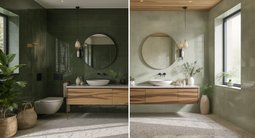
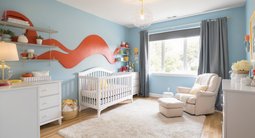
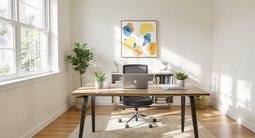
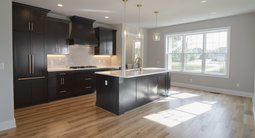


.png)